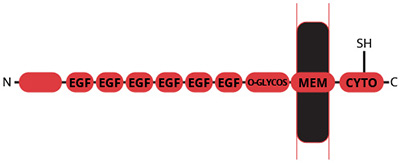Thrombomodulin (TM) is an integral membrane glycoprotein expressed on the surface of endothelial cells. Its discovery by Esmon and Owen has focused attention on the importance of the protein C anticoagulant pathway (1,2). TM serves as a cofactor for protein C activation by forming a 1:1 stoichiometric complex with thrombin (Kd=10-10M), which accelerates the rate of protein C activation by 1000-fold relative to the rate with thrombin alone. In addition to facilitating protein C activation, the binding of thrombin to TM drastically alters the procoagulant activity of thrombin. When bound to TM, thrombin no longer clots fibrinogen, activates factor V, inactivates protein S or triggers platelet aggregation.
TM is a single chain protein composed of 5 distinct domains. The domain structure of TM is similar to the low density lipoprotein (LDL) receptor. A short cytoplasmic domain containing a free cysteine is located at the COOH-terminal end and is joined by a membrane spanning region to an O-glycosylation rich domain. The latter is followed by an epidermal growth factor (EGF) homology region and the NH2-terminal hydrophobic domain. The EGF homology region contains 6 EGF-like domains and contains the binding sites for both thrombin and protein C.
Thrombomodulin is isolated from rabbit lung by a modification (3) of the procedure described by Galvin et al. (4) and is supplied as an aqueous solution in 0.02 M Tris, 0.15 M NaCl, pH 7.4, containing 0.05 % polidocanol, and can be stored at -80°C for up to a year. Purity is determined by SDS-PAGE analysis and activity is determined using a chromogenic assay for protein C activation.

